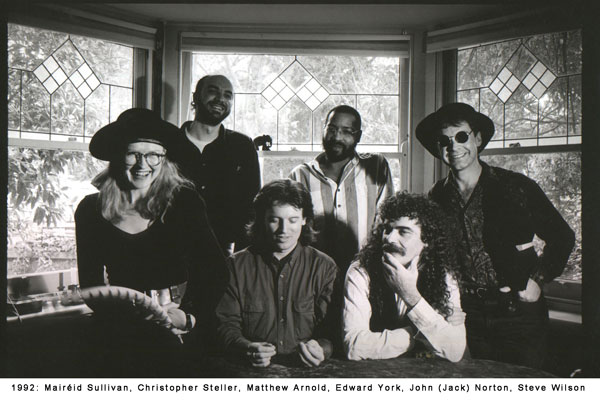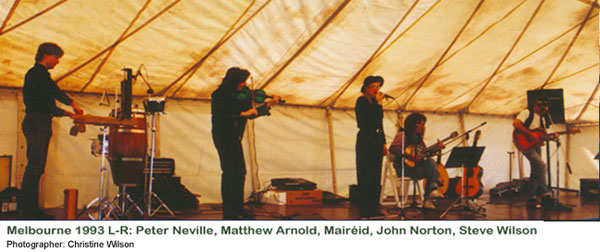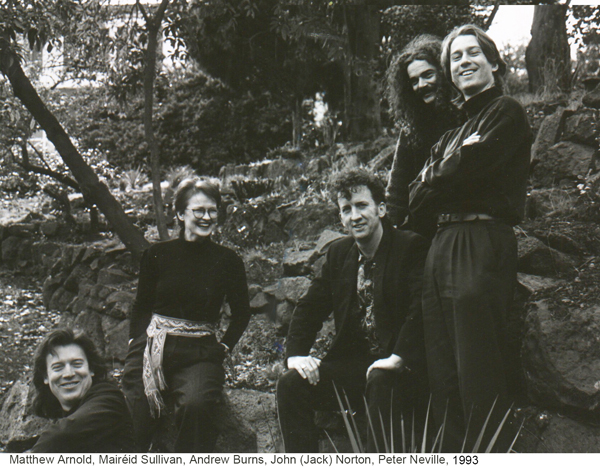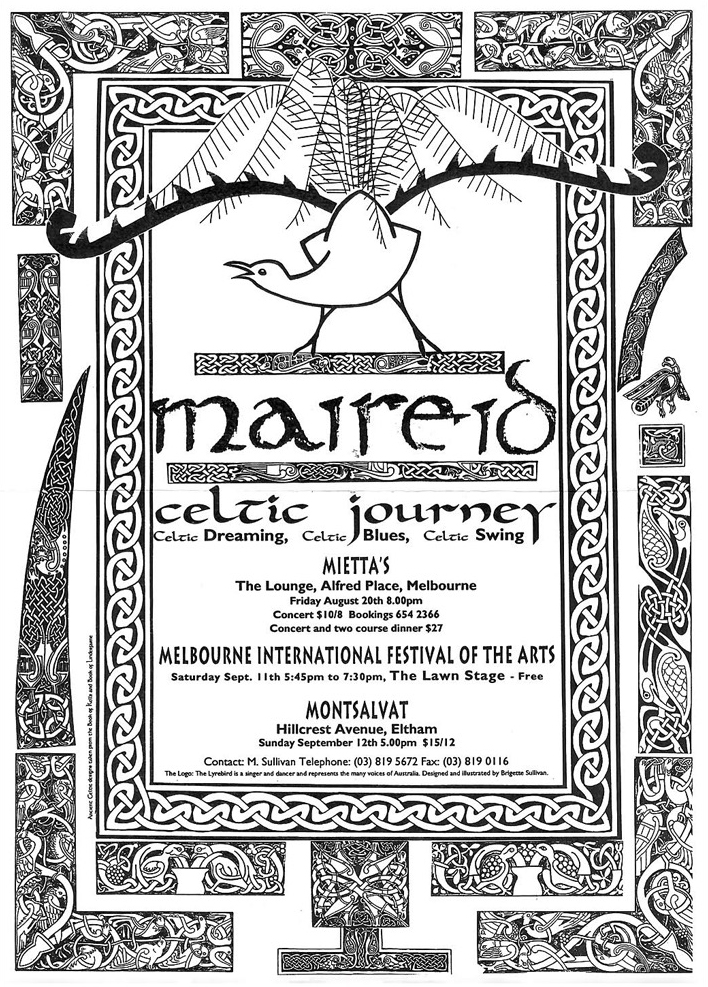Concert Press Releases
By Mairéid Sullivan
- Part 1 - 1992: Celtic Roots in Australia
- Part 2 - 1993: Celtic Journey
- Part 3 - 1993: Celtic Swing
September 1992 marked the launch of Mairéid's ensemble,
performing at eight of Melbourne's leading venues and festivals:
 |
Press Release Logo:
The Lyrebird is a singer and a dancer
and represents the many voices of Australia.
Designed and illustrated by my daughter, Brigette. |
"The singing is beautiful and the music is excellent."
- Patrick Cronin, Music Festival CoOrdinator, Melbourne International Festival, 1992
"At last the huge Celtic heritage of Australia produces a group that uses the sounds and instruments of the traditional Irish session to create music that is resonant to today."
- Moira Jankins, Melbourne Fringe Arts Festival Co-Ordinator 1992
From Memory:
Before we launched our first concert series, in September 1992, our six months of bi-weekly rehearsals, at my place, were thrilling! Rehearsals were modeled on a form of 'ambient acoustic' improvisation: Contemporary / world music - intuitively 'shaping' the arrangement of the music, following the ancient Buddhist concept of Ikebana - "way of flowers" - the harmony of flowers 'shaping space' - so that the music could be equally fulfilling for each of us. It definitely proved a successful approach, because we were very happy working together!
Part 1
1992
Celtic Roots in Australia - Contemporary and Traditional Songs
From our Roots to the Spheres - from Poetry to Song
July 1992

Celtic Roots in Australia
Maireid Sullivan
July 1992
There is reputed to be a 30% Celtic heritage in the Australian population. There is a very strong Irish/Scottish/English folk music tradition which has revived and stereotyped, even fossilised, the traditional music instead of letting it evolve as a source for creative progression.
Australian pop music has traditionally leaned toward America for its inspiration and direction. Whereas, a sense of vibrancy and innovation in Ireland's contemporary music scene has brought Irish music into pop culture and taken a leadership role in bringing world music to the popular music stage. Following in the footsteps of Sean O'Riada, the first composer to arrange harmonies in keeping with Irish musical tradition, using traditional instruments: harpsichord, bodhran, piano, fiddle, accordions, flute, pipes and whistles, exemplified by de Dannan. Planxty, Van Morrison, U2, Christy Moore, Clannad, and many more.
Popular music is benefiting from this opening up to broader musical influences and the melding which that entails. The Australian audience has benefitted from this exposure - more sophisticated and informed in developing broader musical tastes than ever before.
We can add to this influence the world-wide renaissance in Celtic culture which has occurred through the publication, over the last 15 years or so, of an enormous amount of scholarly research which has pieced together the 'lost' knowledge of a great and complex culture: A culture which represented a lifestyle and philosophy conducive to the growth of "personal sovereignty" in the belief that each person is born an empbyonic god or goddess with a capacity to achieve "godhood" and, through the fulfillment of this goal, has a filial duty to assist their "Kith and Kin". Australia has inherited the spirit of egalitarianism which this represents in modern times.
The musical endeavour of this group of musicians is dedicated to using the Celtic cultural concepts in a modern context because those concepts reflect a world view which any culture can relate to–since the concept of "personal sovereignty" is universal.
The original songs reflect on issues which are part of our contemporary experience but the conceptual roots flow from a deep feeling and fascination for the Celtic spirit of individualism and a love for stories representing different styles in the tradition.
PERFORMER Biographies
Maireid Sullivan is lead singer and songwriter and founder of the group.
Maireid has been singing since childhood. She was born in Co. Cork and migrated to San Francisco with her family at the age of twelve. Her father was a singer who encouraged her to sing. Her mother taught her the traditional songs. Her audiences encouraged her to believe that she should sing. All of this has led to a very early belief that she is a singer before anything else in life - and a dancer, second. This is followed
by her quest for knowledge and inspiration via the contemporary issues of her time. Her teenage years in San Francisco exposed her to all the musical developments which went on there. She was an avid supporter of the philosophical individualism which that environment nurtured.
Maireid came to Australia on a holiday with her father, fell in love with Melbourne and stayed. Melbourne had a thriving music and theatre scene when she first arrived and she immersed herself wholly in it as a principally un-accompanied contemporary and traditional singer. She travelled across North East Australia and then on to Asia, Europe and Ireland for some years before returning to Melbourne. Commitment to family prevented her from seriously following her vocation to sing.
As a student
of Celtic culture, Maireid's cultural roots are a source of inspiration.
She has sung various styles of music throughout her life, from blues through to jazz and gospel, but feels that in all of those styles she had to conform to a certain formula which didn't express her personality fully. "Singing and writing songs through the Celtic tradition has allowed me to deal with personal and universal issues in a way that gives me the most freedom for experimentation, personal expression and relationsiip to my audience."
John (Jack) Norton is a Music-Anthropologist and multi-instrumentalist.
He plays Classical and Steel Guitars, Lutes, Bouzouki, Mandolin, Uilleann Pipes, Scottish Pipes, and more. John migrated with his family to Australian from London at the age of seven.
In his adolescence John decided that he would be a Musician. So from playing Guitar in garage bands, he went on to study Classical Guitar. From there he travelled to Italy to study the Lute. A journey to the Middle East altered his musical outlook entirely when he fell in love with Eastern music.
"Certain kinds of music bring out big emotions - stir me - make me want to do something with the music. My aim is to take music which inspires me and try to make it more accessible to people. I am here to entertain people. I'd like people leaping for joy - totally uninhibited - in their appreciation of music. I'm not here to show how fast my fingers can move or how many pieces I can play from memory. You have to be an educator as well so that people can have a better appreciation when they are listening and take something - a better understanding - home."
Matthew Arnold plays Violin and Keyboards. Matthew was born, in Australia, into an extended musical family where from the earliest years everyone was encouraged to play music together. He began his musical studies with the piano as his mother was a pianist. At the age of nine, his first inspired musical experience came when he was given a Violin.
"I remember the impact the beauty of the instrument had on me. I was very curious. I had a feeling it was something special. I had a feeling of positive anticipation and excitement about what was going to take place. I was conscious of the potential and the need to take care to create a beautiful quality sound. I believe this early experience tuned my awareness. It was a good channel for understanding aesthetics. It brought out feelings that were already there. An attraction for passion and beauty and sadness - a sense of sadness, pain and beauty going together. The Violin represents this and can easily express quite sad but beautiful feelings at the same time...that Gypsy thing."
Matthew has travelled the world "locking eyes" with people over his Violin, meeting minds and hearts through his music.
Steve Wilson plays Guitars and Bass. Steve hails form New Zealand where he had achieved some commercial success as a Rock Musician before moving to Australia. The Music of Clannad, Enya, The Waterboys and Hot House Flowers led to his interest in traditional Irish music. He travelled to Ireland to pursue his interest and find inspiration in his Celtic cultural roots. "It's the spirit that's important. The spirit of the music, that's what I'm after."
Edward York is a Percussionist and Composer. Edward immigrated to Australia from New York just three years ago. He is a highly respected and in-demand musician in the Melbourne Jazz scene.
Edward had his first taste of music as a young kid hanging-out at the Apollo Theatre in Harlem. His inspiration to study percussion came from the famous R&B and Soul Acts he heard there. He studied at the famed Stevenson High School Conservatory and later taught Percussion and Theory there. Edward has had an illustrious career in the United States and has toured the world playing and studying with the leading exponents of various styles of Jazz and Fusion music. Composition is his principal interest "Composition is like painting pictures - reflections of personal experience."
Christopher Stellar is an electro-acoustic musician. Chris was born, in Australia, into a family where everyone played music. He has spent his career composing, arranging and creating sound effects for the musical stage, creating soundtracks for film and television and teachng sound technology. Chris believes that synthesizers are the most versatile of instruments. "I can build a sound that suites any environment I am working in."
At the age of 15, Chris was inspired by a Rick Wakeman concert. "I was blown away by the versatility of the sound-creating technology. I started finding out about synthesizers and got my first synth. when was 17. Making music, for me, is like weaving a tapestry of sound. Having a good reproduction of a sound on synth is only a small part of making it work within the context of a song, you need to listen to the way live musicians play."

Part 2
1993: Celtic Journey
back to top

July 1993, Press Release
(pdf)

Our repertoir covers three separate and interchangeable musical concepts which can be described as Contemporary/World Music.
- CELTIC DREAMING: Original and contemporary songs and music.
- CELTIC BLUES: (duet and full ensemble). An anthology of emotional music styles from medieval Europe to America and Australia today.
- CELTIC SWING: Dance music 'to keep the feet from sticking to the floor'.
Maireid Sullivan - Singer/Songwriter
Matthew Arnold - Violin, Keyboard
John Norton - Guitars, Lutes, Bouzouki, Pipes, Vocals
Peter Neville - Percussion, Vibraphone
Luke O'Neill - Guitar
Dominic McAlinden - Bodhran (Irish Drum), Conga
Michael Jordon - Drums, Vocals
Gary Costello - Bass
There is a wonderful sense of excitement in developing a musical project like this.
The musicians are excellent, creative, energetic and committed.
Since the launch of our first concert series in July 1992, we have exjoyed wonderful experimentation with musical styles and ideas.
Our group takes a creative and innovative approach in leading people to discover their cultural heritage and think differently about it. Music offers a common ground and meeting point for diverse cultures faced with difficulties which require understanding and compromise, compassion and dignity.
Singing has always been my great love. When I stepped over the threshold into the study of Celtic history a whole new world of ideas and wonder opened up for me. I am amazed at what I have discovered. It is a good thing for modern people to look back on the cultural paths we have taken because it is helpful in our effort to understand the present so that we can be free to create a fresh and original future.
I first met Mathew when we played in a music theatre production in 1977. I was very impressed with his broad musical knowledge, improvisation skills and lyricism. So, when I came to bringing this group of musicians together, he was the first person I sought out. And here he was! He was back in Melbourne after spending several years in India.
John is known in acoustic music circles as ' the Wizard'. He is a Music Anthropologist and instrument maker. John studied early music in London and Italy and developed his improvisational skills with Arab music in the Middle East. He is also a 'mean' Blues player and singer. Together we created the Celtic Blues concept.
I first heard Peter performing with the Melbourne Symphony. Peter's eclectic musical style was shaped by his early attraction to the strength of the rhythmic element, the dynamism of the harmony, of 20th-century classical music. Peter also has a sharp wit which keeps us on our toes.
Luke joined us after spending four years in the forests of Northern New South Wales whilst studying Music Composition at the University of New England. Luke is curious to learn more about his Celtic cultural roots. He is a wonderful musician.
Dominic first played with us at the Port Fairy Festival. He is the best Bodhran player I have ever heard. Dominic grew up in an Irish family in England. Traditional music and dance were a part of his everyday life. Dominic's love of percussion began with the spoons and progressed to the Bodhran, then kit drums and conga.
I knew of Michael's formidable reputation long before I met him. He is very much in demand as a freelance drummer and he teaches Improvisation Studies at the Vic. College of Music. I discovered that from the age of five he toured England and Ireland in his father's Irish band. He revealed a life-long ambition to recapture the 'lilt' in Irish rhythms and the way it made him feel as a child. He told me about his concept of Celtic Swing and joined the group to take us on a new journey.
Michael suggested I call Gary Costello because they both had shared this special interest in Irish rhythm. Gary is a highly respected and brilliant Bass player. I cannot imagine anyone playing Bass as interestingly as Gary does with our kind of music.
The result of this development in our music will have to be witnessed for yourselves.
Maireid Sullivan, Band Leader
Part 3
1993: Celtic Swing
Back to top
Introducing “Celtic Swing” . . .
Press Release
November 13 and 20th, and December 11 and 18th, 1993
Mietta’s, 7 Alfred Place, Melbourne
Maireid Sullivan, John Norton, Matthew Arnold, Gary Costello, Michael Jordan, Doug deVries
Music Charms, entrances and thrills. Music, old, new & exotic, is not limited to superficial fascination. The soul reveals itself through emotional gestures in music and offers another means of expressing and celebrating aloneness and togetherness.
Boundaries between cultures are crumbling and the world has become a global village where we may venture into many fields of traditional music and come into contact with local masters to blend old and new.
This last few decades has seen musical form move through experiments and collaborations fused stylistically. We have been seeking and discovering the unfamiliar, integrating it and going the long way around to appreciate the familiar in fundamental traditions.
The aim is to ‘suss-out’ carefully the mode that has survived in a traditional form while retaining its identity and improvising a new idea in the moment of play. Thus expressing a feeling to play in a certain way that liberates the music; a contemporary idea so subtle that no matter what it is put with, the vitality of the music is enhanced.
While creative impulses assert originality, we must know the cultural ethos of the music. It must be firmly implanted so that understanding can be used to create a new idea without losing or contradicting the character of the music. The roots must be there but we should not be bound to those roots.
“Beat comes from the song” It can be sound- a motif every now and then - contributing to the musical form or it can be silence. Celtic music is spirited music which has as improvised vibrance. For this to continue it needs to maintain a fresh sense about it and, therefore, a large improvised element.
A world-wide renaissance of Celtic culture is occurring through the spread of music. People of Celtic heritage are restoring the vast mythological and philosophical richness of their ancient heritage.
Our music is dedicated to the evocative feeling and beauty of Celtic cultural concepts, music and songs, interpreted in a modern context.
The Celts were a complex Indo-European tribal high culture reaching from Asia-Minor across northern Europe. Celtic culture presented a lifestyle and philosophy conducive to the growth of personal sovereignty, romanticism and love of communication: The spirit of egalitarianism.
The travels of the Celtic people across the great oceans to the new worlds has contributed wonderful cultural collaborations in the growth of modern musical styles.
We will meet at Mietta’s on Saturday afternoons over the next two months to experiment with these ideas in an informal and friendly atmosphere. We look forward to sharing our music with you.
Maireid Sullivan
October 1993 |
back to top
|

